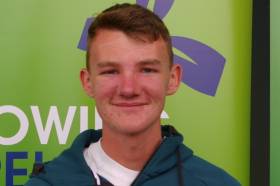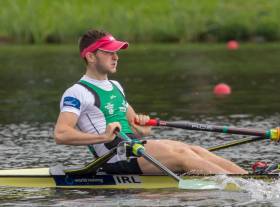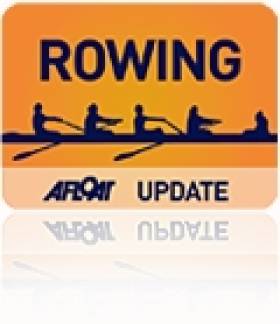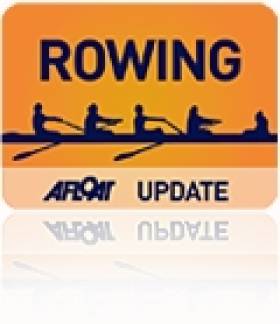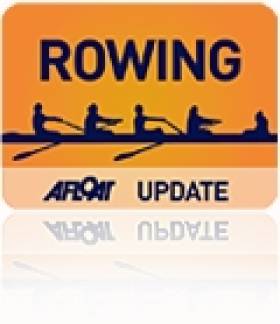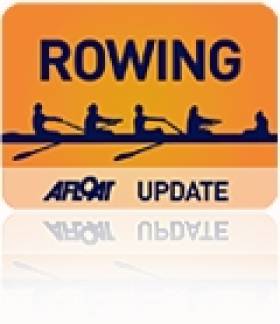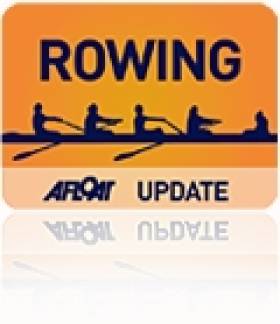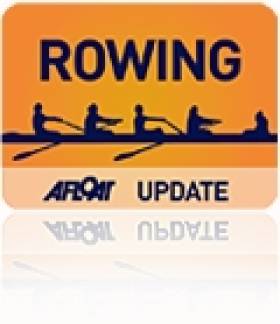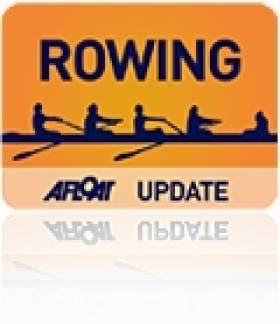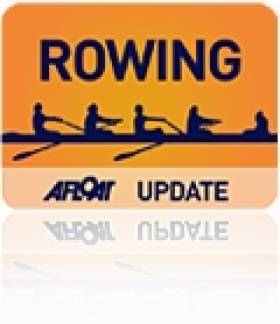Displaying items by tag: World Rowing Championships
Great Finish By Young Ireland Rowing Crew at World Championships
#Rowing: A stirring finish saw the Ireland lightweight quadruple elbow their way into the semi-final of the World Under-23 Championships in Rotterdam today. The young crew of Fintan McCarthy, Shane O'Connell, Stephen O'Connor and Colm Hennessy clung on to third behind impressive Germany and Sweden despite a big challenge by Canada.
World Rowing Championships, Rotterdam (Selected Results; Irish interest)
Men
Under-23 Lightweight Pair - Heat Two (First Three to A/B Semi-Final; rest to Repechages): 1 Turkey 6:39.80, 2 Greece 6:40.70, 3 Ireland (S Mulvaney, D O’Malley) 6:45.09.
Under-23 Quadruple - Heat Three (First two A/B Semi-Final; rest to Repechages) 1 Australia 5:52.01, 2 Italy 5:53.31; 5 Ireland (D Buckley, J Casey, P Boomer, S McKeown) 6:15.47.
Under-23 Lightweight Quadruple - Heat One (First Three to A/B Semi-Finals; rest to Repechages): 1 Germany 6:10.05, 2 Sweden 6:11.08, 3 Ireland (F McCarthy, S O'Connell, S O'Connor, C Hennessy) 6:12.63.
Single and Double Success Brings O'Donovan Afloat Honour
#Rowing: Paul O’Donovan is set to have an extraordinary August, competing at the Olympic Games in Rio de Janeiro and the World Rowing Championships in Rotterdam. He is named the Afloat Rower of the Month for his achievements in June. Paul and his brother, Gary, continued their impressive run in the lightweight double sculls. They took fourth in the World Cup regatta in Poznan, Poland. They placed ahead of Britain, who were silver medallists at the World Championships in 2015, in both the repechage and the final. Germany, who were sixth last year, could not qualify from the repechage, which was won by Ireland in the fastest time they have done in a race. They head off to a block of training in Spain having moved from 11th in the world last year to a ranking of 5th in the bookies’ odds for Rio.
Paul O’Donovan has been chosen to compete in the lightweight single in Rotterdam. In a shoot-out with Gary at Cork Regatta in the senior single he proved his credentials with a big win. Despite being a lightweight, he is the best single sculler in Ireland.
Rower of the Month awards: The judging panel is made up of Liam Gorman, rowing correspondent of The Irish Times, and David O'Brien, editor of Afloat magazine. Monthly awards for achievements during the year will appear on afloat.ie and the overall national award will be presented to the person or crew who, in the judges' opinion, achieved the most notable results in, or made the most significant contribution to rowing during 2016. Keep a monthly eye on progress and watch our 2016 champions list grow.
Puspure So Close to World Rowing Championships Bronze Medal
#ROWING: Ireland’s encouraging campaign at the World Rowing Championships ended with another remarkable result today. Sanita Puspure took fourth in the women’s single sculls, just 1.17 seconds off a medal in this high-profile discipline. Emma Twigg of New Zealand won gold, vanquishing her Australian rival Kim Crow, who took silver. Duan Jingli of China made third her own for the second half of the race. But Puspure, who was fourth by four seconds at 1500 metres, threw everything she had into the last 250 metres. She closed fast on the Chinese and was just half a boatlength behind her on the line.
World Rowing Championships, Day Eight (Irish interest, selected results):
Men
Lightweight Four – A Final: 1 Denmark 5:47.15, 2 New Zealand 5:48.76, 3 Britain (M Aldred, P Chambers, R Chambers, C Bartley) 5:49.58.
Women
Double Sculls – B Final (Places 7 to 12): 1 Netherlands 5:06.20, 2 Russia 5:09.13, 3 Germany 5:09.17, 4 Ukraine 5:14.12, 5 Ireland (H Hannigan, M Dukarska) 5:16.36, 6 Denmark 5:16.55.
Single Sculls – A Final: 1 New Zealand (E Twigg) 7:14.95, 2 Australia (K Crow) 7:17.33, 3 China (Jingli Duan) 7:22.57; 4 Ireland (S Puspure) 7:23.74, 5 Austria 7:32.04, 6 Russia 7:36.64.
New Ireland Double 11th at World Rowing Championships
#ROWING: Ireland’s women’s double of Monika Dukarska and Helen Hannigan (Walshe) finished fifth in their B Final at the World Rowing Championships in Amsterdam this morning. The race was won by the Netherlands, who got out in front early and held off challenges by Germany and Russia. Ireland started well but slipped back to sixth position. However, the crew dug in and won a battle with Denmark for fifth. They finished well, closing up on fourth-placed Ukraine coming up to the line. The placing puts Ireland 11th in this Olympic-class event.
World Rowing Championships, Day Eight (Irish interest, selected results):
Women
Double Sculls – B Final (Places 7 to 12): 1 Netherlands 5:06.20, 2 Russia 5:09.13, 3 Germany 5:09.17, 4 Ukraine 5:14.12, 5 Ireland (H Hannigan, M Dukarska) 5:16.36, 6 Denmark 5:16.55.
O'Donovan Fourth in Record-Breaking World Rowing Final
#ROWING: Paul O’Donovan finished fourth in an extraordinarily-fast A Final of the lightweight single sculls at the World Rowing Championships in Amsterdam today. The race winner, Marcello Miani of Italy, set the world’s best time, and second-placed Lars Hartig of Germany also finished inisde the old record in the tailwind conditions. O’Donovan (20) was the slowest over the first 500 metres. He came from behind to pick off Pedro Fraga of Portugal and Perry Ward of Australia, but even his outstanding speed in the closing stages could not bridge the gap to Michael Schmid of Switzerland, who took bronze.
The world's best time had earlier been breached by American Andrew Campbell Junior of the United Sates in the C Final, but Miani and Hartig bettered it again.
World Rowing Championships, Amsterdam, Day Six (Irish interest, selected results)
Men
Lightweight Four – Semi-Final (First Three to A Final): 1 Denmark 5:43.16 (world best time), 2 Britian (M Aldred, P Chambers, R Chambers, C Bartley) 5:43.97, 3 New Zealand 5:47.95.
Lightweight Pair – B Final (Places 7 to 12): 1 China (Zhenwei Hou, Fangbing Zhang) 6:28.29, 2 Bulgaria 6:30.40, 3 Netherlands 6:31.01, 4 Ireland (M O’Donovan, N Kenny) 6:34.06, 5 Austria 6:37.65, 6 Chile 6:43.01.
Lightweight Single Sculls – A Final: 1 Italy (M Miani) 6:43.37, 2 Germany (L Hartig) 6:46.73, 3 Switzerland (M Schmid) 6:50.88; 4 Ireland (P O’Donovan) 6:50.88, 5 Australia 6:59.84, 6 Portugal 7:07.94.
Women
Four – B Final (Places 7 to 10): 1 Netherlands 6:28.95, 2 Italy 6:35.51, 3 Germany 6:37.90, 4 Ireland (M O’Neill, E Tormey, A Keogh, B O’Brien) 6:43.62.
Double – A/B Semi-Final (First Three to A Final; rest to B Final) 1 Australia (O Aldersey, S Kehoe) 6:37.31 (new World Best Time), 2 Lithuania (D Vistartaite, M Valciukaite) 6:30.34, 3 New Zealand (F Bourke, Z Stevenson) 6:43.34; 4 Netherlands 6:46.40, 5 Ukraine 6:59.20, 6 Ireland (H Hannigan, M Dukarska) 7:14.75.
Lightweight Double Sculls – C Final (Places 13 to 18): 1 Russia (D Stepochkina, O Arkadova) 6:58.21, 2 Ireland (C Lambe, D Walsh) 7:00.11, 3 Denmark 7:03.49, 4 Switzerland 7:03.51, 5 Belarus 7:09.08, 6 Greece 7:14.20.
Single – A/B Semi-Final (First Three to A Final; rest to B Final)
Ireland (S Puspure): 1 New Zealand (E Twigg) 7:18.68, 2 Austria (M Lobnig) 7:23.93, 3 Ireland (S Puspure) 7:25.61; 4 United States 7:29.18, 5 Lithuania 7:33.09, 6 Czech Republic 7:43.150.
Puspure Masters Choppy Waters to Take Place in World Rowing A Final
#ROWING: Sanita Puspure secured an A Final place for Ireland with an admirable performance in difficult conditions in the semi-final of the women’s single sculls at the World Championships in Amsterdam today. Puspure fought her way into third place behind the impressive Emma Twigg of New Zealand and Magdalena Lobnig of Austria early on and held this down the course in choppy water. She refused to yield to a strong challenge from Genevra Stone of the United States and closed up on Lobnig in the run to the line.
The Ireland women’s double of Helen Hannigan and Monika Dukarska finished sixth in a record-breaking semi-final. Sally Kehoe and Olympia Aldersey of Australia won in a new world’s best time. Ireland started quite well, but were not in real contention for a place in the A Final.
There was also a new record in the lightweight men’s four semi-final. Denmark ousted their own country’s great crew of the 1990s from the record books while second-placed Britain, with the Chambers brothers, Peter and Richard, in the two and three seats, also came in under the old record.
World Rowing Championships, Amsterdam, Day Six (Irish interest, selected results)
Men
Lightweight Four – Semi-Final (First Three to A Final): 1 Denmark 5:43.16 (world best time), 2 Britian (M Aldred, P Chambers, R Chambers, C Bartley) 5:43.97, 3 New Zealand 5:47.95.
Lightweight Pair – B Final (Places 7 to 12): 1 China (Zhenwei Hou, Fangbing Zhang) 6:28.29, 2 Bulgaria 6:30.40, 3 Netherlands 6:31.01, 4 Ireland (M O’Donovan, N Kenny) 6:34.06, 5 Austria 6:37.65, 6 Chile 6:43.01.
Women
Four – B Final (Places 7 to 10): 1 Netherlands 6:28.95, 2 Italy 6:35.51, 3 Germany 6:37.90, 4 Ireland (M O’Neill, E Tormey, A Keogh, B O’Brien) 6:43.62.
Double – A/B Semi-Final (First Three to A Final; rest to B Final) 1 Australia (O Aldersey, S Kehoe) 6:37.31 (new World Best Time), 2 Lithuania (D Vistartaite, M Valciukaite) 6:30.34, 3 New Zealand (F Bourke, Z Stevenson) 6:43.34; 4 Netherlands 6:46.40, 5 Ukraine 6:59.20, 6 Ireland (H Hannigan, M Dukarska) 7:14.75.
Lightweight Double Sculls – C Final (Places 13 to 18): 1 Russia (D Stepochkina, O Arkadova) 6:58.21, 2 Ireland (C Lambe, D Walsh) 7:00.11, 3 Denmark 7:03.49, 4 Switzerland 7:03.51, 5 Belarus 7:09.08, 6 Greece 7:14.20.
Single – A/B Semi-Final (First Three to A Final; rest to B Final): 1 New Zealand (E Twigg) 7:18.68, 2 Austria (M Lobnig) 7:23.93, 3 Ireland (S Puspure) 7:25.61; 4 United States 7:29.18, 5 Lithuania 7:33.09, 6 Czech Republic 7:43.150.
Tenth Places for Two Ireland Crews at World Rowing Championships
#ROWING: Ireland’s men’s lightweight pair finished fourth in their B Final, 10th overall, at the World Rowing Championships in Amsterdam today. China won in a fast time in tailwind conditions, with Bulgaria and the Netherlands battling each other and finishing second and third. Ireland’s Niall Kenny and Mark O’Donovan were fifth through the middle stages but won their own battle with Austria to take a clear fourth.
The women’s four of Marie O'Neill, Emily Tormey, Aifric Keogh and Barbara O'Brien were fourth in their B Final, behind the Netherlands, who won impressively from Italy, with Germany third.
World Rowing Championships, Amsterdam, Day Six (Irish interest, selected results)
Men
Lightweight Pair – B Final (Places 7 to 12): 1 China (Zhenwei Hou, Fangbing Zhang) 6:28.29, 2 Bulgaria 6:30.40, 3 Netherlands 6:31.01, 4 Ireland (M O’Donovan, N Kenny) 6:34.06, 5 Austria 6:37.65, 6 Chile 6:43.01.
Women
Four – B Final (Places 7 to 10): 1 Netherlands 6:28.95, 2 Italy 6:35.51, 3 Germany 6:37.90, 4 Ireland (M O’Neill, E Tormey, A Keogh, B O’Brien) 6:43.62.
Lightweight Double Sculls – C Final (Places 13 to 18): 1 Russia (D Stepochkina, O Arkadova) 6:58.21, 2 Ireland (C Lambe, D Walsh) 7:00.11, 3 Denmark 7:03.49, 4 Switzerland 7:03.51, 5 Belarus 7:09.08, 6 Greece 7:14.20.
Frustration For Ireland as Russia Take First in World Rowing C Final
#ROWING: Ireland’s lightweight double scull of Claire Lambe and Denise Walsh came second to Russia in their C Final at the World Rowing Championships in Amsterdam this morning. The Russian crew of Diana Stepochkina and Olga Arkadova led all the way down the course, with Ireland snapping at their heels. But the Irish fell short by just under a boat length. The result places Lambe and Walsh 14th overall in this Olympic-class event.
World Rowing Championships, Amsterdam, Day Six (Irish interest, selected results)
Women
Lightweight Double Sculls – C Final (Places 13 to 18): 1 Russia (D Stepochkina, O Arkadova) 6:58.21, 2 Ireland (C Lambe, D Walsh) 7:00.11, 3 Denmark 7:03.49, 4 Switzerland 7:03.51, 5 Belarus 7:09.08, 6 Greece 7:14.20.
O'Donovan Accelerates Into A Final at World Rowing Championships
#ROWING: Paul O’Donovan gave Ireland its first A Final place at the World Rowing Championships in Amsterdam today with a stirring performance which yielded second place in the lightweight single sculls semi-final. The UCD man lagged the field in the early stages; he was sixth at 500 metres as Zhao Jingbin of China and Marcello Miani of Italy commanded the race. By halfway O’Donovan was marginally in third place, but still over three seconds behind the leaders. As Miani moved clear in the final 1,000 metres, O’Donovan chased down and passed the Chinese. In a close finish, O’Donovan and Perry Ward of Australia took second and third, with Zhao Jingbin pushed into fourth and the B Final.
The Ireland lightweight men’s pair of Mark O’Donovan and Niall Kenny finished sixth in their semi-final and must settle for a B Final place. This was an exciting and fast race where all the boats were in with a chance of qualification until the very final stages, Switzerland, France and Australia took the A Final spots.
World Rowing Championships, Day Five (Irish interest; selected results)
Men
Lightweight Pair – A/B Semi-Final One (First Three to A Final; rest to B Final): 1 Switzerland (S Niepmann, L Tramer) 6:38.67, 2 France (A Mouterde, T Baroukh) 6:41.22, 3 Australia (A Foot, D Purcell) 6:42.39; 4 Bulgaria 6:44.00, 5 Netherlands 6:45.00, 6 Ireland (M O’Donovan, N Kenny) 6:46.60.
Lightweight Single Scull – A/B Semi-Final One (First Three to A Final; rest to B Final): 1 Italy (M Miani) 7:02.00, 2 Ireland (P O’Donovan) 7:03.59, 3 Australia (P Ward) 7:04.10; 4 China 7:04.99, 5 Denmark 7:08.21, 6 Hungary 7:15.08.
Women
Pair – A/B Semi-Final Two (First Three to A Final; rest to B Final): 1 United States (M Kalmoe, K Simmonds) 7:16.35, 2 New Zealand (L Trappitt, R Scown) 7:22.12, 3 Australia (C Sutherland, L Stephan) 7:30.02; 4 Serbia 7:34.92, 5 Ireland (L Kennedy, L Dilleen) 7:35.18, 6 Czech Republic 7:45.68.
Lightweight Double Sculls - C/D Semi-Final (First Three to C Final; rest to D Final): 1 Denmark 7:25.98, 2 Ireland (C Lambe, D Walsh) 7:26.35, 3 Russia 7:26.65; 4 Argentina 7:27.24.
Lambe and Walsh Come Through in Cracking World Rowing Race
#ROWING: Ireland’s lightweight double scull of Claire Lambe and Denise Walsh finished second in a remarkably close C/D Semi-Final of the World Rowing Championships this morning in Amsterdam, and thus qualified for the C Final. Russia held the lead for most of the race, but Denmark and Ireland pulled level with them in the closing stages and the fourth combatant, Argentina, closed up on these three. Denmark won, from Ireland and Russia, with all three boats covered by .67 of a second; Argentina were .59 of a second behind Russia, but go to the D Final.
World Rowing Championships, Day Five (Irish interest; selected results)
Women
Pair – Semi-Final Two (First Three to A Final; rest to B Final): 1 United States (M Kalmoe, K Simmonds) 7:16.35, 2 New Zealand (L Trappitt, R Scown) 7:22.12, 3 Australia (C Sutherland, L Stephan) 7:30.02; 4 Serbia 7:34.92, 5 Ireland (L Kennedy, L Dilleen) 7:35.18, 6 Czech Republic 7:45.68.
Lightweight Double Sculls - C/D Semi-Final (First Three to C Final; rest to D Final): 1 Denmark 7:25.98, 2 Ireland (C Lambe, D Walsh) 7:26.35, 3 Russia 7:26.65; 4 Argentina 7:27.24.


























